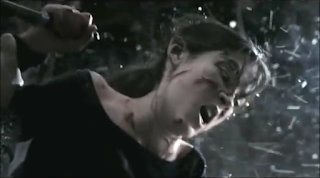Mise-en-scene means, the assortment of scenery and stage properties in a play. Mise-en-scene consists of 5 elements, which are; Positioning of characters, Setting and iconography, Lighting and colour, Costume, Hair and Make up and Facial expression and Body language. The scene i have chosen to analyse is from the film "Orphan". https://www.youtube.com/watch?v=bDWTQajOiuw
 |
| Costume, hair and make-up/Colour - 0:25 |
 |
| Setting and Iconography - 0:49 |
 |
| Positioning of characters - 0:55 |
 |
| Facial expression and body language - 2:54 |
Overall, I think that the use of mine-en-scene in the film Orphan was very effective towards the audience in making them engaged and excited while watching the film. The research that I have just made will guide and help me when creating my own thriller as it has shown me various different techniques of mine-en-scene which i can use to portray many different meanings. In my thriller I will hopefully include all 5 elements of mise-en-scene into my thriller, but if that is not done then I will most definitely include; Facial expression and body language, Costume hair and make-up and positioning of characters. This is because i believe that these 3 elements are the most important out of the 5 in order to creating a suspenseful tense thriller which will excite and uplift the audience, whilst also scaring them.
This post demonstrates a good understanding of how mise-en-scene is used within your chosen sequence. You have identified the main points and have considered the hidden meanings/messages behind the sequence in detail.
ReplyDeleteAim-
1) Consider the themes of shock, surprise and suspense and include this within your analysis
2) Include detailed points on the lighting style and angles that were used and the effect that is created.